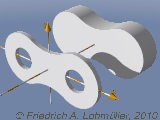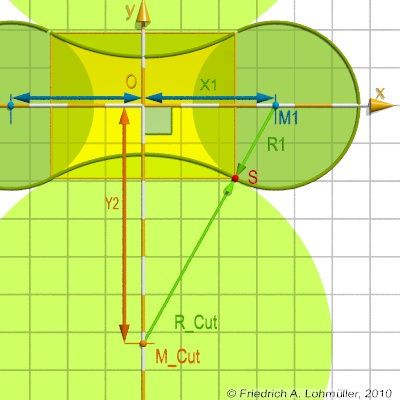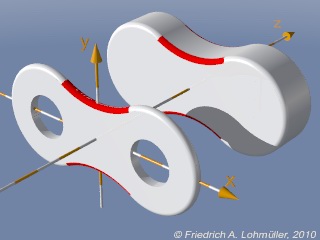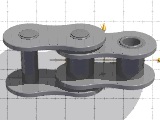//---------------------------------------
#macro Two_Cylinder_Blob_0(
Pitch, // distance of centers
SD, // slice thickness in z
Cyl_R, // cylinder radius
Fillet_R , // fillet radius
Axis_R, // <Cyl_R, 0=non
) //-----------------------------
//---------------------------------------
#local D = 0.00001; // a little bit
// distance of fillet from centerline
// of right and left cylinder:
#local Fillet_Y =
sqrt( pow(Fillet_R+Cyl_R,2)
- pow(Pitch/2,2));
// S = tangent point of the cylinders!
// proportional!
#local S_X =
Fillet_R/(Cyl_R + Fillet_R)*Pitch;
#local S_Y =
Cyl_R/(Cyl_R + Fillet_R)*Fillet_Y;
//---------------------------------------
#if (Axis_R > 0)
difference{
#end //----------------------------------
union{
cylinder{ <0,0,-SD/2>,<0,0,SD/2>,Cyl_R
translate< Pitch/2,0,0>}
cylinder{ <0,0,-SD/2>,<0,0,SD/2>,Cyl_R
translate<-Pitch/2,0,0>}
difference{ // 2
box{<-S_X,-S_Y,-SD/2>,<S_X,S_Y,SD/2> }
cylinder{ <0,0,-SD/2-D>,
<0,0,SD/2+D>, Fillet_R
translate<0, Fillet_Y,0>}
cylinder{ <0,0,-SD/2-D>,
<0,0,SD/2+D>, Fillet_R
translate<0,-Fillet_Y,0>}
} // end difference 2
} // end union -------------------------
#if (Axis_R > 0)
cylinder{<0,0,-SD-D>,<0,0,SD/2+D>,Axis_R
translate< Pitch/2,0,0>}
cylinder{<0,0,-SD-D>,<0,0,SD/2+D>,Axis_R
translate<-Pitch/2,0,0>}
} // end of difference or union
#end // of 'Axis_R > 0'
#end //--------------------- end of macro
//---------------------------------------
// example://----------------------------
object{ Two_Cylinder_Blob_0 (
0.0127, // Pitch distance
0.0009, // slice thickness
0.0051, // cylinder radius
0.0081, // fillet radius
0.0022, // axis r,
//< cylinder r, 0=non
)//-----------------------------
texture{
pigment{ color rgb<1,1,1>}
finish { phong 1.0}
} // end of texture
rotate<0,0,0>
translate<0,0,0>
} // end of sphere ----------------
//--------------------------------------- |



